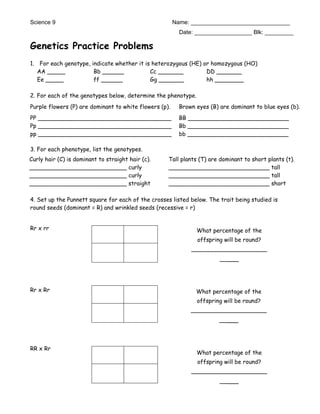Sci 9 Genetics Practice Problems
- 1. Science 9 Name: _______________________________ Date: __________________ Blk: _________ Genetics Practice Problems 1. For each genotype, indicate whether it is heterozygous (HE) or homozygous (HO) AA _____ Bb ______ Cc _______ DD _______ Ee _____ ff ______ Gg _______ hh ________ 2. For each of the genotypes below, determine the phenotype. Purple flowers (P) are dominant to white flowers (p). Brown eyes (B) are dominant to blue eyes (b). PP _____________________________________ BB ____________________________ Pp _____________________________________ Bb ____________________________ pp _____________________________________ bb ____________________________ 3. For each phenotype, list the genotypes. Curly hair (C) is dominant to straight hair (c). Tall plants (T) are dominant to short plants (t). ___________________________ curly ____________________________ tall ___________________________ curly ____________________________ tall ___________________________ straight ____________________________ short 4. Set up the Punnett square for each of the crosses listed below. The trait being studied is round seeds (dominant = R) and wrinkled seeds (recessive = r) Rr x rr What percentage of the offspring will be round? _____________________ _____ Rr x Rr What percentage of the offspring will be round? _____________________ _____ RR x Rr What percentage of the offspring will be round? _____________________ _____
- 2. Practice with Crosses. Please show all work! 5. A TT (tall) plant is crossed with a tt (short) plant. What percentage of the offspring will be tall? 6. A Tt plant is crossed with a Tt plant. What percentage of the offspring will be short? 7. In pea plants, purple flowers (P) are dominant to white flowers (p). If two white flowered plants are crossed, what percentage of their offspring will be white flowered? 8. A white flowered plant is crossed with a plant that is heterozygous for the trait. What percentage of the offspring will have purple flowers? 9. Two plants, both heterozygous for the gene that controls flower color, are crossed. What percentage of their offspring will have purple flowers? What percentage will have white flowers?

